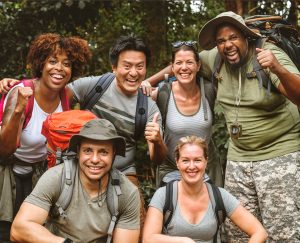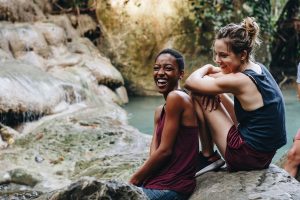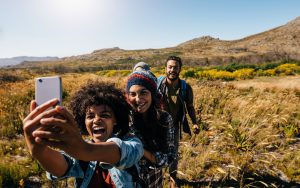After more than seven months of canceled flights, hotel closures, and restricted access to popular destinations worldwide, the adventure travel business received some much-needed good news. The 2020 COVID-19 Pandemic had pretty much brought foreign and even domestic travel to an absolute standstill, but on the horizon is a remarkable opportunity to welcome back much of the business activity the industry has lost as well as a yet untapped customer base. Data from a new study commissioned by the Adventure Travel Trade Association, Flywire, and the Dominican Republic Tourism Board reveals that consumers who identify as people of color represent more than $51 Billion in potential adventure travel revenue.

The Diversity in Adventure Travel Report: U.S. Travelers of Color issued in October shows that 36 percent of U.S. outbound adventure travelers were non-white. Collectively, that’s 22 million men and women of color over the age of 18. Qualified respondents to a survey of likely travelers had to have taken at least one international adventure leisure trip in the past 24 months and intend to take another adventure leisure trip in the next 24 months. Answers to a series of questions regarding their travel behavior demonstrate that spending patterns and capacity among people of color is very similar to their white counterparts. The report shows, for example, that Black adventure travelers, between 2018 and 2019, spent $19 Billion.
“I actually think these numbers are kind of low,” said Evita Robinson, founder of the global Black travel community known as the Nomadness Travel Tribe. “But if we’re talking just about adventure travel, I suppose that sounds about right. Black travel in general is much higher. That just means there’s a big opportunity for growth.”
A 2018 study by Mandala Research reported that the Black American travel market alone is valued at more than $63 Billion. The ATTA diversity report merely shows what many have known for years, Black people are adventure travelers! Robinson and other POC travel professionals believe that the adventure travel industry in particular could benefit from directly marketing its services and destinations to racial and ethnic communities that are too often overlooked. Fortunately, they say that doesn’t mean that trip organizers have to make major changes to what they have to offer or even their messaging.

“You just have to change the way your messaging looks,” said Martinique Lewis, a diversity in travel consultant and president of the Black Travel Alliance. “You can keep the same exact messaging, but it’s who you show in that picture and then putting money behind it. You have to then figure out all the different places that you can connect with this customer based off of their influencers or the things that they are influenced by.”
Representation is critical. Through advertising and imagery on social media travel destinations must demonstrate that people of color are indeed welcome.
“I know it’s cliché but I need to see myself in that mountaineering ad,” said Lola Akinmade Åkerstrōm, a Black travel writer and photographer based in Sweden. “If I don’t see myself in it and it’s still just the rugged white guy that looks like he just came down from Everest, then I will feel that it’s not a space for me. But if they show people that look like me, doing those things then the adventure industry is actively saying, you’re welcome. It’s no longer a white boys’ club.”
Disparities in access to personal wealth and social mobility have for decades, even centuries, allowed many adventure travel destinations and their related activities to become segregated along racial lines. The same systems of oppression and discrimination that deprived people of color the means and opportunity to achieve equality as citizens also prevented them from experiencing the great outdoors for recreation. Backpacking, kayaking, mountain biking and skiing are typically pastimes that are popular among those with the disposable income, leisure time and cultural inclination necessary to pursue them. But as people of color in the U.S. and around the world have improved their economic stability and affluence, many of these activities are now within reach of a much broader cross section of the population. This new study shows that non-white consumers represent a lucrative and emerging demographic of impressionable customers. The adventure travel industry just has to figure out how to reach them.
“You have a sweet spot you don’t realize, and I guarantee you’re not utilizing it correctly,” said Evita Robinson. “The only person that knows what it’s like to be in your destination and experience it from the Black point of view are the Black people that live there as residents.”

Experts agree that the best way to directly engage communities of color is to frankly ask them what they want. Though the conversations may be somewhat awkward and uncomfortable, a sincere effort to achieve an authentic understanding of the audiences you want to reach can go a long way toward creating the experiences and amenities your customers want most.
“You need to seek them out. You need to take them out to dinner. You need to take them out for a drink, invite them down to the board of tourism office,” Robinson said. “It may be a humbling experience, but you’re going to learn stuff. You need to approach it from the space of being a student at all times. Take those notes and start to craft what an experience can be.”
Like all expressions of hospitality, adventure travel is about putting people at ease and allowing them to feel comfortable. When it comes to connecting with people of color it’s important to manifest points of engagement that are authentic. Marketing materials and social media content should be created using producers and firms with a specialty in framing stories from the POC perspective.
“Don’t try to tell our stories for us. Be our amplification, not our storytellers,” Robinson said. “That’s not your job. It’s also not your expertise, because this isn’t your point of view.”
The consequence of doing a poor job of community engagement is making a brand-damaging mistake. In the current “cancel culture climate” many organizations would rather do nothing at all than risk, despite their best efforts, the prospects of doing something horribly wrong or offensive. The reality is the world is changing. If we fail to address the needs of these new customers, adventure travel destinations and the industry as a whole could become culturally irrelevant.

Sophia Hyder Hock, a diversity and social inclusion consultant says the best place to begin is to admit and even embrace what you don’t know about the markets you’re trying to reach. “It takes an understanding that I don’t know everything, and I want to learn,” she said. “However you reach out to that audience, ask the question. We’re trying to learn. Can you help us?”
It’s from this attitude of genuine curiosity and a willingness to understand that we can transform the industry to become more diverse and inclusive of all people. If travel destinations and trip providers can tap into this market, we can become a global force of economic recovery as we slowly emerge and rebuild from the COVID-19 Pandemic. But we must be prepared to be vulnerable and willing to make mistakes along the way.
“Diversity and inclusion sound like a check box that people are going through,” Hyder Hock said. “But if we’re open to more ideas and perspectives, that opens an avenue of innovation that’s completely untapped. That goes beyond color. It goes to being open to different perspectives so you can have more innovative ideas.”

Armed with the knowledge from this new report we are aware that this market exists. By engaging new customers in a different way, we can welcome more people from all walks of life to our destinations and lead them on our trips. As we learned from the report, outbound U.S. adventure travelers of color are spending comparable amounts to white adventure travelers from the U.S. overall, but spend more in-destination on things like dining, tours, shopping, entertainment and transportation.
“For too long the travel industry has not spent time or money on meaningful quantitative and qualitative research on travelers of color, including adventure travel. The findings clearly show what a miss this has been in terms of economic opportunity, and highlights why representation matters in all facets of our businesses,” said ATTA CEO Shannon Stowell. “We're excited about the power of this data to show how important it is that the ATTA and our industry work for better representation of the diversity of people in the world in which we live.”
Through broader representation and diversity of participants, the adventure travel industry can affirm its strength and longevity for years to come. The road ahead may seem long and more than a bit frightening, but with the right guides we can make our way forward to a brighter future. And what a great adventure it will be!
Learn more about James at joytripproject.com.
The 56-page Diversity in Adventure Travel: U.S. Travelers of Color report is free and available for download, courtesy of sponsors Flywire and Dominican Republic.
